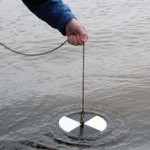Secchi Day Results Released
12 Nov 2010 Once a year for the past five years, Beaver Lake has had an annual physical exam. And it’s all thanks to volunteer scientists who take time out on a Saturday to help with the effort during Secchi Day on Beaver Lake, held in August each year.
Once a year for the past five years, Beaver Lake has had an annual physical exam. And it’s all thanks to volunteer scientists who take time out on a Saturday to help with the effort during Secchi Day on Beaver Lake, held in August each year.
“Our dedicated citizen scientists are the heart and soul of Secchi Day,” said Dr. Robert Morgan P.E., Manager of Environmental Quality for Beaver Water District. “It simply wouldn’t be possible for one or two people to get this many measurements in one day. I don’t have enough lab technicians to get this many measurements done in a single day.”
More than 300 people participated in the 5th Annual Secchi Day on Beaver Lake on Aug. 21. The event was co-sponsored by Beaver Water District, Audubon Arkansas, the U.S. Army Corps of Engineers-Beaver Lake, the U.S. Geological Survey, the University of Arkansas Cooperative Extension Service, Arkansas Master Naturalist, Hobbs State Park, and the Association for Beaver Lake Environment.
Morgan noted that thanks to volunteers, the District will have a whole decade of annual snapshots of Beaver Lake by 2015.
“This long-term data collection will allow us to evaluate trends in Beaver Lake,” he said. “This is of great importance, since Beaver is the primary drinking water source for one in eight Arkansans.”
Secchi depth is a measure of water transparency that involves lowering a black and white disk into the water and recording the measurement when the disk is no longer visible. Deeper depths indicate water that is clearer than shallower depths. Secchi measurements this year ranged from .5 meters (1.6 feet) in the War Eagle arm of the lake to 5.5 meters (18.04 feet) near Beaver Dam.
In addition to Secchi depth readings, volunteers also collect water samples. Then Beaver Water District’s lab technicians measure chlorophyll a, total phosphorous, and nitrate in each of the water samples. Chlorophyll a is a pigment in algae that is used to measure the density of the algal population in water. Phosphorous and nitrate are both nutrients that promote algal growth. “Phosphorus from fertilizer and other sources attaches to soil particles. Storm water runoff carries with it a lot of soil particles and phosphorous. This is what is meant by the term ‘non-point source water pollution,’ ” Morgan said.
He added that the object is to reduce the amount of phosphorous entering Beaver Lake. It’s important to educate residents about how phosphorous enters the lake. Examples include fertilizer runoff from lawns, erosion from unpaved county roads, and erosion from stream banks. Additionally, where residents have cleared stream side vegetation (also known as riparian buffers) it is easier for the banks to erode. Eroding banks contribute sediment to the stream and degrade the water quality.
“All of these activities can negatively impact water clarity and water quality in Beaver Lake,” he said. “The District and its partners in Secchi Day are committed to educating the community about best management practices that will curb impacts from these activities and protect the lake’s water quality. After all, Beaver Lake is our drinking water. And abundant, quality drinking water is necessary for good health. It’s also essential for a strong economic base and for quality of life for Northwest Arkansans.”
A detailed report Secchi Day 2010 Report with graphics may be accessed via the Beaver Water District website at www.bwdh2o.org. Next year’s event will be held on Aug. 20, 2011. For more information, visit www.bwdh2o.org.
Welcome to BeaverLakeBoaters!
This site is devoted to all things Beaver Lake Arkansas
Categories





Comments are closed.